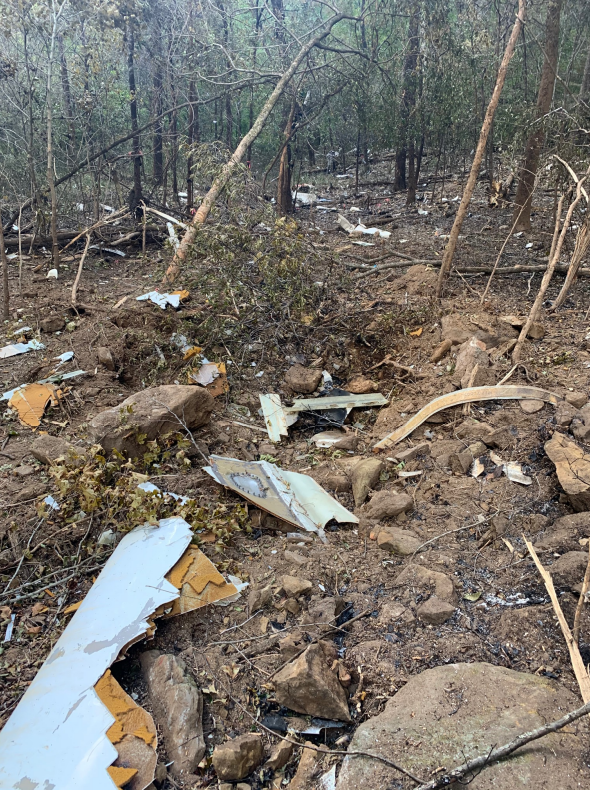
ASN Wikibase Occurrence # 240943
This information is added by users of ASN. Neither ASN nor the Flight Safety Foundation are responsible for the completeness or correctness of this information.
If you feel this information is incomplete or incorrect, you can submit corrected information.
| Date: | Friday 4 September 2020 |
| Time: | 20:55 |
| Type: |  Cirrus SR22 |
| Owner/operator: | Private |
| Registration: | N733CD |
| MSN: | 0134 |
| Year of manufacture: | 2001 |
| Total airframe hrs: | 2053 hours |
| Engine model: | Continental |
| Fatalities: | Fatalities: 4 / Occupants: 4 |
| Aircraft damage: | Destroyed |
| Category: | Accident |
| Location: | Chester, AR -
 United States of America United States of America
|
| Phase: | En route |
| Nature: | Private |
| Departure airport: | Muskogee-Davis Field, OK (KMKO) |
| Pickens Airport, SC (LQK/KLQK) | |
| Investigating agency: | NTSB |
| Confidence Rating: |
The noninstrument-rated pilot and three passengers departed on a visual flight rules (VFR) cross-country flight in dark night visual meteorological conditions. The pilot established contact with air traffic control and requested VFR flight-following to the destination airport; shortly thereafter, the controller provided a 20° right turn around an area of precipitation ahead of the airplane. The pilot acknowledged and flew the suggested heading for a short time before he turned left toward the area of precipitation. When queried by the controller, the pilot replied that he was returning to the departure airport; however, the pilot did not establish a heading toward the airport. When queried again, the pilot stated that, “the wind caught me” and that he was correcting the airplane’s heading. Shortly thereafter, the airplane began a turning descent and radar contact was lost, about 6 minutes after the pilot’s initial contact with air traffic control. The wreckage was found the next day in wooded terrain. Examination did not reveal any mechanical malfunctions or anomalies that would have precluded normal operation.
Based on flight track and weather information, the pilot likely encountered instrument meteorological conditions and turbulence when the airplane flew in close proximity to an area of convective activity as depicted on radar just before the accident. The pilot’s inability to respond positively to ATC-provided vectors and maintain altitude before the turning descent is consistent with the pilot experiencing spatial disorientation. The pilot’s inability to maintain aircraft control under those conditions was likely exacerbated by the presence of frequent lightning.
Although the pilot obtained a weather briefing for the accident flight about 17 hours before the planned departure time, there were no records to indicate that he obtained updated weather information, which would have reflected increased potential for convective activity along the planned route.
The pilot purchased the airplane about 8 months before the accident and received transition training in the airplane, which included use of the avionics suite. Instructors who flew with the pilot in the accident airplane reported that the installed avionics was “old technology” and “not easy to use.” Although the airplane was equipped with an autopilot, the extent to which the pilot may have used the autopilot during the accident flight could not be determined. Review of the pilot’s logbook indicated that he did not meet recency of experience requirements to carry passengers at night.
Toxicology testing of the pilot revealed the presence of ethanol; however, it is most likely that some or all of the identified low concentration of ethanol was from sources other than ingestion. Thus, the identified ethanol did not contribute to this accident.
Probable Cause: The noninstrument-rated pilot’s continued flight into dark night instrument meteorological conditions which resulted in spatial disorientation and a subsequent loss of airplane control.
Accident investigation:
 |
|
Sources:
NTSB
https://www.hsvvoice.com/news/20200905/no-survivors-in-friday-night-plane-crash-in-chester
https://flightaware.com/live/flight/N733CD/history/20200905/0128Z/KMKO/L%2035.69355%20-94.26248
https://cdn.jetphotos.com/full/1/72029_1074993913.jpg (photo)
Location
Images:

Photo: NTSB
Revision history:
| Date/time | Contributor | Updates |
|---|---|---|
| 05-Sep-2020 18:36 | gerard57 | Added |
| 05-Sep-2020 18:42 | harro | Updated [Aircraft type, Source] |
| 05-Sep-2020 18:53 | harro | Updated [Registration, Cn, Departure airport, Source, Narrative] |
| 06-Sep-2020 05:44 | Anon. | Updated [Time, Location, Destination airport, Source, Narrative] |
| 06-Sep-2020 09:57 | Captain Adam | Updated [Location, Narrative] |
| 07-Sep-2020 02:12 | RobertMB | Updated [Destination airport, Source, Narrative] |
| 23-Sep-2020 12:00 | ASN Update Bot | Updated [Time, Departure airport, Destination airport, Source, Narrative, Accident report] |
| 28-Jun-2022 23:51 | Captain Adam | Updated [Location, Departure airport, Destination airport, Source, Narrative, Accident report, Photo] |
Corrections or additions? ... Edit this accident description
The Aviation Safety Network is an exclusive service provided by:


 ©2024 Flight Safety Foundation
©2024 Flight Safety Foundation